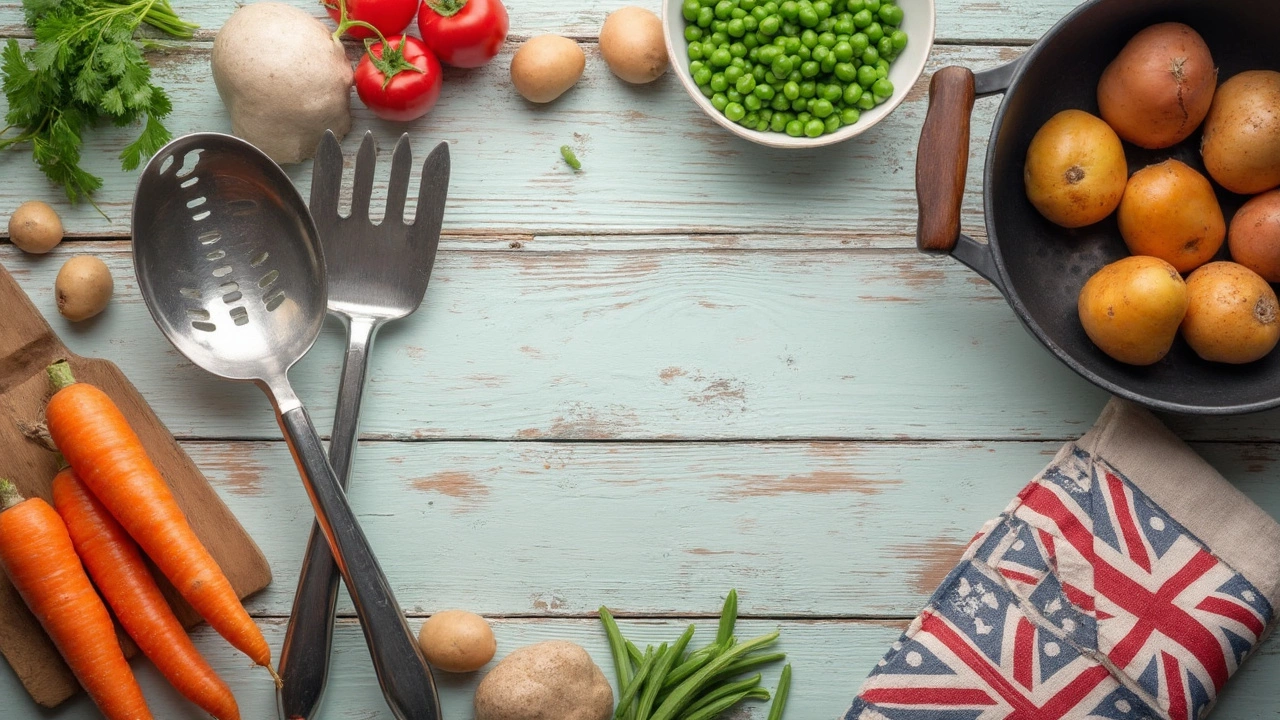Ladle with Holes: What Is It Really Called and How Do You Use One?

Spot one of those ladles with holes sitting in a kitchen drawer and you might just call it a slotted spoon. But it's got a few other names that actually matter if you’re shopping or trying out a new recipe. People often mix up what to buy—skimmer, slotted spoon, or that thing with the holes?
If you’ve ever tried fishing meatballs out of soup or scooped veggies from boiling water, you know just grabbing any spoon won’t cut it. The holes are there to drain the liquid fast, and yes, there are real reasons to use the right one for the job. Let’s get straight to what this kitchen staple is called, why you need one, and how to make it last in your drawer for years.
- The Real Name of a Ladle with Holes
- How It’s Different from Regular Ladles
- When and Why You’d Use One
- Types You’ll See in the Kitchen
- Handy Tips for Cleaning and Care
- Common Mistakes and Smart Solutions
The Real Name of a Ladle with Holes
You might have heard people say "ladle with holes," but in kitchenware, it actually goes by two main names: the slotted spoon and the skimmer. If the holes look more like slots or long cuts, it’s usually called a slotted spoon. If it’s round and full of small holes, that’s a skimmer. Both do similar jobs—lifting food out while letting liquid drain away—but the design can make a difference for certain foods.
Why do the names matter? Well, if you’re browsing for one online or asking someone for a kitchen recommendation, these names will help you pick the right tool, and you’ll avoid accidentally buying the wrong utensil. Also, professional chefs and most modern recipes use these words, so knowing which is which means less confusion during cooking.
Here’s a handy breakdown of the most common names you’ll see, and what they usually look like:
| Tool Name | Description | Best For |
|---|---|---|
| Slotted Spoon | Spoon shape, with wide slots or holes | Veggies, eggs, pasta, fried food |
| Skimmer | Usually round, lots of small holes | Skimming froth, removing food from hot oil or water |
| Perforated Ladle | Deep, ladle-shaped, with many small holes | Heavier foods in soups or stocks |
If you’re in Europe or Asia, you might hear local names too. For example, in France, a skimmer is called an “écumoire,” and in Italy, a slotted pasta spoon is sometimes known as a “schiumarola.” American stores almost always stick with "slotted spoon" for flat ones and "skimmer" for bigger and rounder ones.
Lots of kitchen sets include both, sometimes even in mini sizes for smaller jobs. So, next time you’re reaching for your ladle with holes, just remember which shape you want and what you’re lifting—it could save your dinner, and maybe a little frustration too.
How It’s Different from Regular Ladles
Okay, let’s break it down. A regular ladle is like a deep bowl on a stick. It’s perfect for scooping up soups, chili, or stew and pouring them right into bowls. There are no holes, so every scoop brings both the liquid and solid bits with it. Simple and good for most brothy jobs.
Now, the reason a ladle with holes exists is for draining. The holes or slots let you lift solids out of liquid without bringing the soup or sauce along for the ride. If you want veggies out of boiling water, meatballs from broth, or fried food out of hot oil, this tool is your go-to. No mess, no extra liquid splashing everywhere.
Here’s a quick side-by-side for the pros and cons:
| Feature | Regular Ladle | Ladle with Holes |
|---|---|---|
| Use | Serving thick or liquid dishes | Draining and serving solids |
| Shape | Deep rounded bowl | Shallower bowl, perforated or slotted |
| Foods | Soups, gravies, sauces | Vegetables, pasta, fried items |
| Liquid Transfer | Transfers all liquid | Drains liquid |
| Mess | Can be drippy | Keeps counters cleaner |
One last thing: don’t confuse the slotted ladle or skimmer with a regular spoon with a few slots. A real ladle with holes holds a bunch of food at once, while a basic slotted spoon is smaller and less handy for big batches. If you do a lot of cooking, both types earn their space in the drawer, but for serious draining, you’ll want the one with the holes.
When and Why You’d Use One
So, when does a ladle with holes actually come in handy? It’s all about separating solid foods from liquids quickly and easily. That’s why you see these get called into action for lots of common kitchen tasks, way more often than you’d think.
When you’re boiling eggs, pasta, or dumplings, a regular spoon turns the job into a mess. The holes help you scoop out what’s cooked while leaving the hot water behind. If you’re frying anything—think chicken nuggets or French fries—a skimmer or slotted spoon lifts the food out while letting the oil drain off. That’s not just tidier; it keeps your food crispier too.
- Scooping poached eggs so the yolks don’t break
- Skimming foam or fat off simmering broths and soups
- Draining canned vegetables or beans in one quick move
- Lifting fried foods straight from the pan without burning your hands
- Fishing out blanched veggies fast so they don’t overcook
A ladle with holes also saves you time. Compare draining veggies by flipping over a whole pot and straining, versus scooping them out with the right tool. Less mess, fewer dishes, and you aren’t chasing peas around your sink. Check out this simple table showing where holey ladles outshine the rest:
| Task | Slotted Ladle/Skimmer | Regular Spoon |
|---|---|---|
| Draining pasta | Fast, no spill | Pasta slips, liquid stays |
| Removing fried food | Oils drains, food crisp | Oily, soggy food |
| Poached eggs | Eggs intact, no water | Eggs break easily |
One quick tip: if you ever try canning or making homemade jam, a ladle with holes is your best friend for skimming off the foamy stuff on top. It makes the finished product look and taste way better. Turns out, this kitchen tool isn’t just for professional chefs—it’s perfect for pretty much any home cook who wants things faster, safer, and way less messy.

Types You’ll See in the Kitchen
You’ll spot a few different versions of that ladle with holes depending on what job needs doing. Not every tool with holes works the same, so here’s a rundown of what actually ends up in real kitchens.
- Slotted Spoon: This is the workhorse. It looks just like a big spoon, except for those slots or holes in the bowl, perfect for fishing veggies or poached eggs out of liquid. It drains fat from fried food in a pinch too.
- Skimmer: This one comes with a wide, flat, usually round head covered in lots of small holes. It’s ideal for skimming foam off soup, scooping dumplings out of a pot, or even lifting out pasta. If you work with boiling water or fried food, you probably reach for this a lot.
- Perforated Ladle: Looks just like a standard ladle (with a deep bowl) but covered in small holes or circular cut-outs. It’s your go-to for serving stews, beans, or anything that needs draining without making a big mess.
- Spider Strainer: Sounds dramatic, but it’s a super handy tool. It has a wide mesh basket with a handle—great for deep frying, fishing out dumplings, or moving noodles.
Manufacturers make these tools in all sorts of materials. Stainless steel versions are the most popular—they last the longest, don’t stain or hold smells, and handle boiling temps like a champ. Plastic ones work fine for nonstick pans, but heat can make them warp if you’re not careful. Bamboo shows up in Asian kitchens, especially for delicate foods, but they might not last as long.
Surprised by how many choices? Here’s a quick look at how they line up for different uses:
| Type | Best For | Typical Material | Heat Resistance |
|---|---|---|---|
| Slotted Spoon | Veggies, poached eggs, draining fat | Stainless steel, plastic | Up to 400°F |
| Skimmer | Foam, dumplings, pasta | Stainless steel, bamboo | Up to 500°F |
| Perforated Ladle | Stews, beans, soups | Stainless steel | Up to 600°F |
| Spider Strainer | Fried foods, noodles | Stainless steel, bamboo | Up to 450°F |
Choosing the right type makes cooking and cleanup way easier, and you don’t have to stress about wrecking your pan or missing lumps of food. Grab the one that suits your dish, and you’ll save time and energy in the kitchen.
Handy Tips for Cleaning and Care
Those holes in your slotted spoon or skimmer make draining easy, but they can turn cleaning into a chore. Food bits love to get stuck, and greasy residue isn’t always obvious. Here’s how to keep yours spotless and safe for cooking.
- Rinse right after use, especially if you’ve handled starchy or cheesy foods. Dried batter or cheese can clog up the holes fast.
- Run a little soapy water and scrub with a brush, not just a sponge. A brush gets into those holes and makes sure nothing’s stuck.
- If your ladle with holes is stainless steel, it’s usually dishwasher safe. Plastics might be, but check if your handle or head warps in high heat—the package or handle usually says.
- For stubborn bits, soak it in hot (not boiling) water mixed with baking soda for 15 minutes. Even cooked-on sauce or rice bits wipe off after that.
- Don’t forget to dry fully with a towel to keep metal from rusting and plastic from getting that weird musty smell.
If you’re cleaning a slotted spoon that’s been used to fry food, a degreasing soap helps. Skip abrasive pads on nonstick-coated spoons so you don’t scratch them up.
People always ask about germs, too. Want stats? Bacteria counts on kitchenware drop by over 99% when you use hot water (over 140°F/60°C) and dish soap. The chart below might help if you’re wondering how long different materials take to dry or if they’re prone to gunk build-up:
| Material | Dishwasher Safe? | Dry Time (Minutes) | Gunk Buildup Risk |
|---|---|---|---|
| Stainless Steel | Yes | 10 | Low |
| Nylon/Plastic | Check Label | 15 | Medium |
| Wood | No | 25 | High (if not dried) |
One last thing: if you spot rust or weird stains, try a baking soda paste or replace the spoon if the damage is deep. No one wants bits of rust in their soup. Proper cleaning keeps your kitchen tools working better and lasting longer.
Common Mistakes and Smart Solutions
It’s easy to mess up with a ladle with holes if you don’t know what makes it work best. Let’s run through a few of the most common slip-ups and how you can fix them fast.
- Choosing the wrong tool: People often grab a plain ladle when they actually need a slotted spoon or skimmer. Regular ladles won’t separate solids from liquids; your veggies will end up soggy and no one likes that. Stick with the tool with lots of holes for draining.
- Using it on sticky foods: Ever tried scooping cooked pasta or dumplings and watched them break apart? That’s because some ladles with holes have sharp edges or holes that don’t suit every food. Go for a gentle-edge skimmer if you’re working with soft items.
- Not cleaning properly: Food bits love to hide in those holes, and bacteria can build up quickly. One tip: Use a brush and soapy water right after cooking, before anything dries and sticks.
- Ignoring the material: Metal slotted spoons are awesome for frying, but can scratch nonstick pans. If you cook with coated pots, grab a silicone or nylon version instead.
- Overloading the spoon: It might be tempting to scoop a lot at once, but you’ll end up spilling or even bending your tool if it’s not sturdy enough. Smaller batches make for a smoother cooking (and serving) process.
These are all super common, so no shame if you’ve done one (or all). Little fixes go a long way to keeping you sane in the kitchen.
Want to avoid headaches and keep your kitchenware in top shape? Check out this mini guide for quick solutions:
| Mistake | Smart Solution |
|---|---|
| Picking a ladle instead of a slotted spoon | Check for holes before serving anything that needs draining |
| Scratching nonstick cookware | Switch to silicone or nylon tools |
| Leaving food stuck inside | Rinse and scrub right after use |
| Breaking delicate food | Choose smooth-edged skimmers for dumplings or pasta |
| Trying to scoop too much | Scoop in small amounts for more control |
The next time you’re pulling out your trusty slotted spoon, these tweaks can help keep things running smoothly. Kitchen tasks get easier when you match the right tool to the job and keep it clean and ready.





